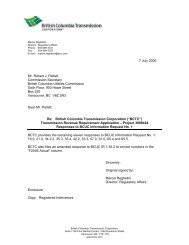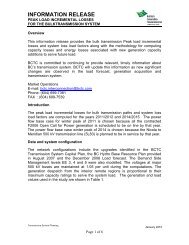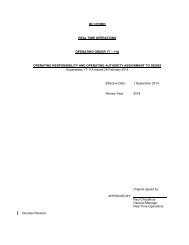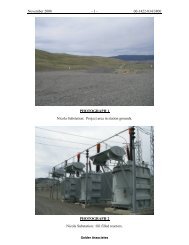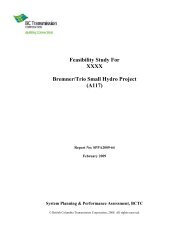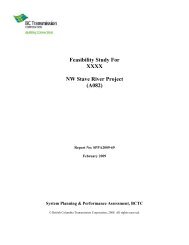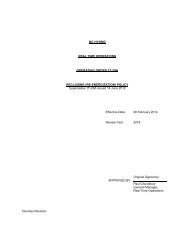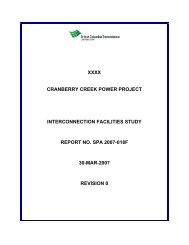Evidence on the Adequacy of First Nations Consultation - BC Hydro ...
Evidence on the Adequacy of First Nations Consultation - BC Hydro ...
Evidence on the Adequacy of First Nations Consultation - BC Hydro ...
Create successful ePaper yourself
Turn your PDF publications into a flip-book with our unique Google optimized e-Paper software.
DRAFT REPORT: Rights and Title Interests in <strong>the</strong> Columbia Valley Transmissi<strong>on</strong> Project Area<br />
<strong>the</strong> 1999 report <strong>on</strong> <strong>the</strong> Salm<strong>on</strong> Beds site by Parks Canada archaeologist Rod Heitzmann. 76<br />
In 1982, Claude Schaeffer also examined <strong>the</strong> <strong>the</strong>n-c<strong>on</strong>tentious issue <strong>of</strong> an eastern origin<br />
<strong>of</strong> <strong>the</strong> Ktunaxa. After reviewing ethnographic sources as well as fur trade records and his<br />
own ethnographic data, Schaeffer c<strong>on</strong>cluded that <strong>on</strong>ly <strong>on</strong>e band <strong>of</strong> Ktunaxa, <strong>the</strong> Michel<br />
Prairie people from <strong>the</strong> Crowsnest Pass area, occupied <strong>the</strong> eastern foothills. He also<br />
c<strong>on</strong>cluded that <strong>the</strong>y suffered to <strong>the</strong> point <strong>of</strong> near extincti<strong>on</strong> both at <strong>the</strong> hands <strong>of</strong> <strong>the</strong>ir<br />
Blackfoot enemies and also from a 1781-1782 smallpox epidemic. It was Schaeffer’s<br />
c<strong>on</strong>clusi<strong>on</strong> that:<br />
David Thomps<strong>on</strong>’s belief, apparently accepted by o<strong>the</strong>r and later<br />
writers, 77 that <strong>the</strong> Kutenai were forcibly driven from <strong>the</strong> nor<strong>the</strong>rn Plains<br />
by <strong>the</strong> Blackfoot, seems entirely err<strong>on</strong>eous. 78<br />
Schaeffer opined that <strong>the</strong>se Michel Prairie people <strong>on</strong>ce occupied both sides <strong>of</strong> <strong>the</strong><br />
Crowsnest Pass regi<strong>on</strong>. Their occupati<strong>on</strong> <strong>of</strong> <strong>the</strong> Plains-Plateau margins, Schaeffer noted,<br />
preceded <strong>the</strong> appearance <strong>of</strong> <strong>the</strong> horse. The Blackfoot, according to Schaeffer’s Ktunaxa<br />
c<strong>on</strong>sultants, were not resident in southwest Alberta at this time. The Michel Prairie band<br />
wintered in <strong>the</strong> east and moved west in <strong>the</strong> spring to hunt and fish, <strong>of</strong>ten in company with<br />
kinsmen from <strong>the</strong> Upper Kutenai band at Tobacco Plains. With this band, <strong>the</strong>y hunted as<br />
far north as Golden. 79<br />
As will be reviewed in secti<strong>on</strong> 2.1.2 and 2.3.1, <strong>the</strong> available ethnographic data supports a<br />
c<strong>on</strong>tinual Ktunaxa presence in <strong>the</strong> general envir<strong>on</strong>s <strong>of</strong> <strong>the</strong> Columbia Valley at <strong>the</strong> time <strong>of</strong><br />
initial c<strong>on</strong>tact with Whites in <strong>the</strong> early 19 th century.<br />
Alexander Henry <strong>the</strong> Younger, factor at <strong>the</strong> Rocky Mountain House site from 1810 to 1811,<br />
provided informati<strong>on</strong> <strong>on</strong> <strong>the</strong> “Snare” people referred to by Chance and by o<strong>the</strong>rs. These “Snare”<br />
people are sometimes associated with a divisi<strong>on</strong> <strong>of</strong> <strong>the</strong> Secwepemc, or Shuswap, and sometimes<br />
associated with an Athabascan group, <strong>the</strong> Sekani. In <strong>the</strong> early 1800s, as reviewed in <strong>the</strong> present<br />
study in more detail in secti<strong>on</strong> 4.2.2, <strong>the</strong>se “Snare” people occupied <strong>the</strong> drainage <strong>of</strong> <strong>the</strong> North<br />
Thomps<strong>on</strong> River upstream from McLure to <strong>the</strong> headwaters <strong>of</strong> Fraser River from McBride to Tête<br />
Jaune Cache, over to Jasper and south to <strong>the</strong> headwaters <strong>of</strong> <strong>the</strong> Athabasca River. According to<br />
John McLeod, <strong>of</strong> <strong>the</strong> H<strong>BC</strong>, <strong>the</strong>y occasi<strong>on</strong>ally went to <strong>the</strong> Canoe River. Alexander Henry said<br />
76 Additi<strong>on</strong>al informati<strong>on</strong> <strong>on</strong> <strong>the</strong> regi<strong>on</strong>al archaeology is presented in <strong>the</strong> December 1999 archaeological<br />
study, “Archaeological Investigati<strong>on</strong>s at <strong>the</strong> Salm<strong>on</strong> Beds,” prepared by Rod Heitzmann <strong>of</strong> Parks Canada. Available<br />
<strong>on</strong>line: http://www.livinglandscapes.bc.ca/cbasin/salm<strong>on</strong>beds/index.htm<br />
77 Alexander Henry. See Coues 1897, pp. 703-705.<br />
78 Schaeffer 1982, page 9. His reference to Thomps<strong>on</strong> is from <strong>the</strong> Glover editi<strong>on</strong> <strong>of</strong> David Thomps<strong>on</strong>’s<br />
Narrative, pp. 327-328.<br />
79 Schaeffer 1982, page 6.<br />
Bouchard & Kennedy Research C<strong>on</strong>sultants Page 16<br />
Page 19 <strong>of</strong> 200






